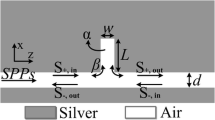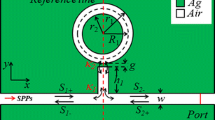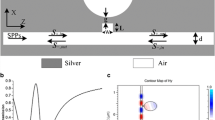Abstract
Spectral splitting is numerically investigated based on the electromagnetically induced transparency (EIT) in a nanoscale plasmonic waveguide resonator system, which consists of a square ring resonator coupled with a stub-shaped metal-insulator-metal (MIM) waveguide. Simulation results show that the transparency window can be easily tuned by changing the geometrical parameters of the structure and the material filled in the resonators. By adding another stub or (and) square ring resonator, multi-EIT-like peaks appear in the broadband transmission spectrum, and the physical mechanism is presented. Our compact plasmonic structure may have potential applications for nanoscale optical switching, nanosensor, nanolaser, and slow-light devices in highly integrated optical circuits.







Similar content being viewed by others

References
Barnes WL, Dereux A, Ebbesen TW (2003) Surface plasmon subwavelength optics. Nature 424(6950):824–830
Lu H, Liu XM, Wang LR, Gong YK, Mao D (2011) Ultrafast all-optical switching in nanoplasmonic waveguide with Kerr nonlinear resonator. Opt Express 19(4):2910–2915
Xiao SS, Liu L, Qiu M (2006) Resonator channel drop filters in a plasmon-polaritons metal. Opt Express 14(7):2932–2937
Chen JJ, Li Z, Yue S, Xiao JH, Gong QH (2012) Plasmon-induced transparency in asymmetric T-shape single slit. Nano Lett 12(5):2494–2498
Lu H, Liu XM, Mao D, Wang GX (2012) Plasmonic nanosensor based on Fano resonance in waveguide-coupled resonators. Opt Lett 37(18):3780–3782
Xu T, Wu YK, Luo XG, Guo LJ (2010) Plasmonic nanoresonators for high-resolution colour filtering and spectral imaging. Nature Commun 1:59
Veronis G, Fan SH (2005) Bends and splitters in metal-dielectric-metal subwavelength plasmonic waveguides. Appl Phys Lett 87:131102
Economou EN (1969) Surface plasmons in thin films. Phys Rev 182:539
Lin XS, Huang XG (2008) Tooth-shaped plasmonic waveguide filters with nanometeric sizes. Opt Lett 33(23):2874–2876
Hosseini A, Massoud Y (2007) Nanoscale surface plasmon based resonator using rectangular geometry. Appl Phys Lett 90:181102
Zhang Q, Huang XG, Lin XS, Tao J, Jin XP (2009) A subwavelength coupler-type MIM optical filter. Opt Express 17(9):7549–7554
Tao J, Huang XG, Lin XS, Zhang Q, Jin XP (2009) A narrow-band subwavelength plasmonic waveguide filter with asymmetrical multiple teeth-shaped structure. Opt Express 17(16):13989–13994
Chen JJ, Li Z, Lei M, Fu XL, Xiao JH, Gong QH (2012) Plasmonic Y-splitters of high wavelength resolution based on strongly coupled-resonator effects. Plasmonics 7(3):441–445
Guo YH, Yan LS, Pan W, Luo B, Wen KH, Guo Z, Li HY, Luo XG (2011) A plasmonic splitter based on slot cavity. Opt Express 19(15):13831–13838
Chen JJ, Li Z, Zou YJ, Deng ZL, Xiao JH, Gong QH (2013) Coupled-resonator-induced fano resonances for plasmonic sensing with ultra-high figure of merits. Plasmonics 8:1627–1632
Zhou ZP, Hu FF, Yi HX (2011) Wavelength demultiplexing structure based on arrayed plasmonic slot cavities. Opt Lett 36(8):1500–1502
Wang GX, Lu H, Liu XM, Mao D, Duan LN (2011) Tunable multi-channel wavelength demultiplexer based on MIM plasmonic nanodisk resonators at telecommunication regime. Opt Express 19(4):3513–3518
Noual A, Akjouj A, Pennec Y, Gillet J, Djafari-Rouhani B (2009) Modeling of two-dimensional nanoscale Y-bent plasmonic waveguides with cavities for demultiplexing of the telecommunication wavelengths. New J Phys 11(10):103020
Lu H, Liu XM, Gong YK, Mao D, Wang LR (2011) Enhancement of transmission efficiency of nanoplasmonic wavelength demultiplexer based on channel drop filters and reflection nanocavities. Opt Express 19(14):12885–12890
Boller KJ, Imamoglu A, Harris SE (1991) Observation of electromagnetically induced transparency. Phys Rev Lett 66(20):2593
Fleischhauer M, Imamoglu A, Marangos JP (2005) Electromagnetically induced transparency: optics in coherent media. Rev Mod Phys 77:633–673
Xu Q, Sandhu S, Povinelli ML, Shakya J, Fan S, Lipson M (2006) Experimental realization of an on-chip all-optical analogue to electromagnetically induced transparency. Phys Rev Lett 96:123901
Naweed A, Farca G, Shopova SI, Rosenberger AT (2005) Induced transparency and absorption in coupled whispering-gallery microresonators. Phys Rev A 71:043804
Liu HC, Amnon Y (2009) Grating induced transparency (GIT) and the dark mode in optical waveguides. Opt Express 17(14):11710–11718
Yang X, Yu M, Kwong DL, Wong CW (2009) All-optical analog to electromagnetically induced transparency in multiple coupled photonic crystal cavities. Phys Rev Lett 102:173902
Zhou JH, Mu D, Yang JH, Han WB, Di X (2011) Coupled-resonator-induced transparency in photonic crystal waveguide resonator systems. Opt Express 19(5):4856–4861
Kekatpure RD, Barnard ES, Cai WS, Brongersma ML (2010) Phase-coupled plasmon-induced transparency. Phys Rev Lett 104:243902
Lu H, Liu X, Mao D, Gong Y, Wang G (2011) Induced transparency in nanoscale plasmonic resonator systems. Opt Lett 36(16):3233–3235
Chen JJ, Wang C, Zhang R, Xiao JH (2013) Multiple plasmon-induced transparencies in coupled-resonator systems. Opt Lett 37(24):5133–5135
Lu H, Liu XM, Wang GX, Mao D (2012) Tunable high-channel-count bandpass plasmonic filters based on an analogue of electromagnetically induced transparency. Nanotech 23:444003
Liu N, Langguth L, Weiss T, Kastel J, Fleisch M, Pfau T, Giedden H (2009) Plasmonic analogue of electromagnetically induced transparency at the Drude damping limit. Nat Mater 8:758–762
Han Z, Forsberg E, He S (2007) Surface plasmon Bragg gratings formed in metal-insulator-metal waveguides. IEEE Photon Technol Lett 19:91–93
Matsuzaki Y, Okamoto T, Haraguchi M, Fukui M, Nakagaki M (2008) Characteristics of gap plasmon waveguide with stub structures. Express 16(21):16314–16325
Nordlander P, Oubre C, Prodan E, Li K, Stockman MI (2004) Plasmon hybridization in nanoparticle dimers. Nano Lett 4(5):899–903
Acknowledgments
This work was supported by the National Natural Science Foundation of China under Grant No. 11374041, National Basic Research Program of China under Grant No. 2010CB923202 and Fund of State Key Laboratory of Information Photonics and Optical Communications (Beijing University of Posts and Telecommunications), People’s Republic of China.
Author information
Authors and Affiliations
Corresponding author
Rights and permissions
About this article
Cite this article
Chen, Z., Wang, W., Cui, L. et al. Spectral Splitting Based on Electromagnetically Induced Transparency in Plasmonic Waveguide Resonator System. Plasmonics 10, 721–727 (2015). https://doi.org/10.1007/s11468-014-9858-1
Received:
Accepted:
Published:
Issue Date:
DOI: https://doi.org/10.1007/s11468-014-9858-1



